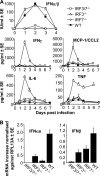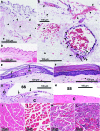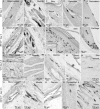Interferon response factors 3 and 7 protect against Chikungunya virus hemorrhagic fever and shock
- PMID: 22761364
- PMCID: PMC3446587
- DOI: 10.1128/JVI.00956-12
Interferon response factors 3 and 7 protect against Chikungunya virus hemorrhagic fever and shock
Abstract
Chikungunya virus (CHIKV) infections can produce severe disease and mortality. Here we show that CHIKV infection of adult mice deficient in interferon response factors 3 and 7 (IRF3/7(-/-)) is lethal. Mortality was associated with undetectable levels of alpha/beta interferon (IFN-α/β) in serum, ∼50- and ∼10-fold increases in levels of IFN-γ and tumor necrosis factor (TNF), respectively, increased virus replication, edema, vasculitis, hemorrhage, fever followed by hypothermia, oliguria, thrombocytopenia, and raised hematocrits. These features are consistent with hemorrhagic shock and were also evident in infected IFN-α/β receptor-deficient mice. In situ hybridization suggested CHIKV infection of endothelium, fibroblasts, skeletal muscle, mononuclear cells, chondrocytes, and keratinocytes in IRF3/7(-/-) mice; all but the latter two stained positive in wild-type mice. Vaccination protected IRF3/7(-/-) mice, suggesting that defective antibody responses were not responsible for mortality. IPS-1- and TRIF-dependent pathways were primarily responsible for IFN-α/β induction, with IRF7 being upregulated >100-fold in infected wild-type mice. These studies suggest that inadequate IFN-α/β responses following virus infection can be sufficient to induce hemorrhagic fever and shock, a finding with implications for understanding severe CHIKV disease and dengue hemorrhagic fever/dengue shock syndrome.
Figures







Similar articles
-
Distinct Roles of Interferon Alpha and Beta in Controlling Chikungunya Virus Replication and Modulating Neutrophil-Mediated Inflammation.J Virol. 2019 Dec 12;94(1):e00841-19. doi: 10.1128/JVI.00841-19. Print 2019 Dec 12. J Virol. 2019. PMID: 31619554 Free PMC article.
-
Cutting edge: independent roles for IRF-3 and IRF-7 in hematopoietic and nonhematopoietic cells during host response to Chikungunya infection.J Immunol. 2012 Apr 1;188(7):2967-71. doi: 10.4049/jimmunol.1103185. Epub 2012 Feb 27. J Immunol. 2012. PMID: 22371392
-
Plasmacytoid dendritic cells control dengue and Chikungunya virus infections via IRF7-regulated interferon responses.Elife. 2018 Jun 19;7:e34273. doi: 10.7554/eLife.34273. Elife. 2018. PMID: 29914621 Free PMC article.
-
Chikungunya disease: infection-associated markers from the acute to the chronic phase of arbovirus-induced arthralgia.PLoS Negl Trop Dis. 2012;6(3):e1446. doi: 10.1371/journal.pntd.0001446. Epub 2012 Mar 27. PLoS Negl Trop Dis. 2012. PMID: 22479654 Free PMC article. Review.
-
Biology and pathogenesis of chikungunya virus.Nat Rev Microbiol. 2010 Jul;8(7):491-500. doi: 10.1038/nrmicro2368. Nat Rev Microbiol. 2010. PMID: 20551973 Review.
Cited by
-
Aedes Mosquito Salivary Components and Their Effect on the Immune Response to Arboviruses.Front Cell Infect Microbiol. 2020 Aug 7;10:407. doi: 10.3389/fcimb.2020.00407. eCollection 2020. Front Cell Infect Microbiol. 2020. PMID: 32850501 Free PMC article. Review.
-
Immunology: How the Microbiota Digests Bile to Protect against Viral Infection.Curr Biol. 2020 Oct 19;30(20):R1271-R1272. doi: 10.1016/j.cub.2020.08.044. Curr Biol. 2020. PMID: 33080200 Free PMC article.
-
Establishment and Comparison of Pathogenicity and Related Neurotropism in Two Age Groups of Immune Competent Mice, C57BL/6J Using an Indian Isolate of Chikungunya Virus (CHIKV).Viruses. 2019 Jun 25;11(6):578. doi: 10.3390/v11060578. Viruses. 2019. PMID: 31242674 Free PMC article.
-
Wolbachia elevates host methyltransferase expression to block an RNA virus early during infection.PLoS Pathog. 2017 Jun 15;13(6):e1006427. doi: 10.1371/journal.ppat.1006427. eCollection 2017 Jun. PLoS Pathog. 2017. PMID: 28617844 Free PMC article.
-
Type I interferon signaling in dendritic cells limits direct antigen presentation and CD8+ T cell responses against an arthritogenic alphavirus.mBio. 2024 Dec 11;15(12):e0293024. doi: 10.1128/mbio.02930-24. Epub 2024 Nov 13. mBio. 2024. PMID: 39535221 Free PMC article.
References
-
- Agarwal SK, et al. 2011. Toll-like receptor 3 upregulation by type I interferon in healthy and scleroderma dermal fibroblasts. Arthritis Res. Ther. 13:R3 doi:10.1186/ar3221 - DOI - PMC - PubMed
-
- Ali U, Isahak I, Rahman MM. 2011. Chikungunya confused with dengue In Malaysia: clinical, serological and molecular perspective. Internet J. Microbiol. 9(2). doi:10.5580/647 - DOI
-
- Buss C, et al. 2010. Essential role of mitochondrial antiviral signaling, IFN-regulatory factor (IRF)3, and IRF7 in Chlamydophila pneumoniae-mediated IFN-beta response and control of bacterial replication in human endothelial cells. J. Immunol. 184:3072–3078 - PubMed
-
- Chen LH, Wilson ME. 2010. Dengue and chikungunya infections in travelers. Curr. Opin. Infect. Dis. 23:438–444 - PubMed
Publication types
MeSH terms
Substances
Grants and funding
LinkOut - more resources
Full Text Sources
Other Literature Sources
Medical
Molecular Biology Databases
Miscellaneous

